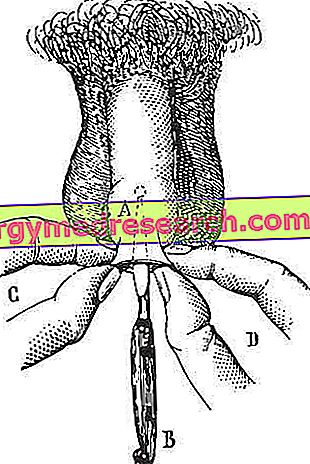Generality
Corneal Cross-Linking (CXL) is a therapeutic option indicated for keratoconus, an eye disease characterized by thinning and progressive corneal deformation.

CLX reinforces the corneal surface, creating new connections between the collagen fibers that make up the stroma, increasing its mechanical strength. The technique exploits the action of riboflavin (vitamin B2) which, subjected to the action of type A ultraviolet rays (UVA), makes the cornea more rigid, therefore less subject to the process of bulging, characteristic of keratoconus.
Corneal Cross-Linking allows, therefore, to contrast and / or stop the evolution of the disease.
What's this
Corneal Cross-Linking is a "low-invasiveness" para-surgical intervention, indicated for the treatment of keratoconus . This degenerative eye disease is characterized by a progressive weakening of the cornea (transparent surface placed in front of the iris) which, over time, leads to its thinning. Over time, keratoconus leads to bulging: being less resistant, the corneal surface - normally round - protrudes outwards and assumes a characteristic cone shape.
Cross-linking involves the creation of bonds between the collagen fibers of the stroma . The procedure exploits the combined effect of riboflavin (vitamin B2) and ultraviolet rays, with the aim of increasing the connection between the fibers and their mechanical strength .
Keratoconus: key points

- What it is : keratoconus is a degenerative disease, often progressive, that causes the deformation of the cornea, which thins and begins to vary its curvature towards the outside, assuming a cone-shaped appearance. Usually, the pathological process begins during adolescence and adulthood, but tends to stabilize after age 40-50. The cone shape assumed by the cornea modifies its refractive power and does not allow the correct passage of the light input towards the internal ocular structures.
- Causes : at the origin of the disease, the intervention of a specific genetic alteration has been hypothesized, from which an imbalance in the corneal layers would derive, with effects on the thickness and resistance capacity of the same.
- Symptoms : the direct consequence of corneal bulging is astigmatism (in this case, the defect is called irregular, as it is not possible to correct with the lenses). Keratoconus can also be associated with myopia and, rarely, hypermetropia. Therefore, the initial symptoms are related to these refractive defects. Keratoconus is a disease that typically requires frequent changes in the prescription of glasses. As the condition progresses, vision becomes progressively more blurred and distorted, as well as increasing sensitivity to light (photophobia) and eye irritation . Sometimes keratoconus causes the appearance of corneal edema and scarring. The presence of scar tissue on the corneal surface causes the loss of its homogeneity and transparency. As a result, opacity may occur which further reduces vision.
- Diagnosis : Keratoconus is diagnosed with:
- Corneal topography : examination that evaluates the conformation of the cornea, studies its surface and monitors the evolution of the disease;
- Pachymetry : measures the thickness of the cornea;
- Confocal microscopy : allows the observation of all the layers of the cornea and identifies any fragility.
- Treatment : keratoconus can be treated with corneal cross-linking, but, in more severe cases, corneal transplantation is required (mandatory if perforation occurs).
Terminology and synonyms
Cross-linking is also known as corneal reriding or photodynamics .
In medical practice, the intervention is abbreviated as CXL or CCL.
Why do you run
Corneal Cross-Linking is a para-surgical treatment intended for patients who present with an evolutionary keratoconus (ie not in an advanced stage). Thanks to the combined action of riboflavin (vitamin B2) and ultraviolet rays (UVA), an increase in molecular bridges is obtained which give greater resistance to the inner layers of the cornea.
In most cases, this intervention allows to stop or slow the progression of the disease and, consequently, the need to resort to corneal transplantation.
Corneal Cross-Linking (CXL): when is it indicated by the doctor?
Corneal Cross-Linking is the therapy of choice for keratoconus forms that show a tendency to progression, when they are not yet in an advanced stage.
Usually, the procedure is recommended for young patients, recently affected by the disease. Clearly, age limits are not strict, as the ophthalmologist will evaluate each case.
To undergo the treatment, however, the cornea must have specific characteristics, as regards its thickness and opacity.
Preparation
The Corneal Cross-Linking procedure is performed in a sterile environment (surgery or operating room), after the administration of an anesthetic eye drops . For this reason, the procedure should not be painful.
Corneal Cross-Linking and Contact Lenses
Before Corneal Cross-Linking, the use of contact lenses should be suspended for a suitable period, established by the eye doctor.
How to do it
Corneale Cross-Linking basically involves two phases:
- Impregnation of the cornea : is obtained by installing drops of eye drops based on riboflavin, a photosensitive vitamin (B2) that, by concentrating in the stroma of the cornea, is able to absorb UV rays. The administrations are repeated every 5 minutes, until reaching a concentration of vitamin B2 sufficient in the cornea;
- Irradiation : the corneal tissue is exposed to a low-dose laser beam of type A ultraviolet (UVA) rays. UV rays make the corneal tissue more rigid by creating bond bridges between the collagen fibers of the stroma, called cross linking.
Corneal Cross-Linking: techniques available
Currently, there are two options for performing Corneal Cross-Linking (CXL), which are distinguished by the removal or not of the corneal epithelium, before the riboflavin is instilled:
- Epi-off technique : it is the traditional method. For the Corneal Cross-Linking the corneal epithelium is initially removed, before the irradiation of vitamin B2 with ultraviolet rays; the epi-off technique is indicated to allow the absorption of riboflavin throughout the thickness of the cornea.
- Epi-on technique : irradiation occurs without removal of the corneal epithelium. This procedure is therefore more suitable for people with too thin corneas, which could not be subjected to the epi-off technique. With this method, however, the intact epithelium can limit the concentration of riboflavin (in the formulation currently available for Corneal Cross-Linking) in the deep layers of the cornea, making the results of the intervention less satisfactory.
The most suitable treatment modality for the patient (with and without epithelium removal) is indicated by the doctor during the evaluation of keratoconus.
How does Corneal Cross-Linking work?

The Corneal Cross-Linking procedure is performed following the administration of a topical anesthetic, in the form of eye drops.
The epi-off technique involves the removal of the first layer of the cornea (epithelium), while in the epi-on procedure this step is not performed.
Subsequently, the corneal surface is irrigated with riboflavin. Soon after, Corneal Cross-Linking involves irradiation of the cornea, in a targeted manner, with a beam of ultraviolet rays.
At the end of the operation the eye is treated with eye drops or antibiotic and bandaged ointment. If the corneal epithelium (epi-off technique) has been removed, a soft and protective therapeutic contact lens can be applied for about 3-4 days.
Corneal Cross-Linking: how long does it last?
Corneale Cross-Linking takes about 30-60 minutes.
After a short period of observation, the patient can be accompanied home by a trusted person, on the same day the treatment is performed.
After the Corneal Cross-Linking, it is contraindicated, in fact, to drive the car, both for the intense and prolonged use of the sight that this activity entails, and for reasons of road safety.
Post-operative care
- After Corneal Cross-Linking, the patient should observe at least two to three days of rest, preferably in bed, in a dimly lit environment. Furthermore, in the days following the surgery, it is important to avoid reading and watching television, trying to sleep at least 10-12 hours a night.
- In the 2-3 days following Corneal Cross-Linking with epithelial removal (epi-off), intense pain, a foreign body sensation and photophobia may occur. Post-operative therapy involves the use of painkillers to reduce this symptomatology. In treatments without epithelium removal (Cross-Linking Corneale epi-on), however, the discomfort is almost completely absent and the recovery faster.
- In the post-operative course or of the Corneal epi-off Cross-Linking, it is important that the patient undergoes periodic checks, daily, until the contact lens is removed.
- In the months following the Corneal Cross-Linking, to verify the settlement and healing of the most superficial layers of the cornea, the follow up includes the following assessments: topography and corneal tomography, computerized optical tomography (OCT) of the anterior segment and endothelial count.
Complications and Risks
Like other types of intervention, the risk of complications cannot be eliminated. The possibility that they occur depends on the severity of the pre-operative eye condition and how the patient follows the post-intervention instructions given by the doctor.
Corneal Cross-Linking: possible adverse effects
The adverse effects of Corneal Cross-Linking are few and, in general, associated with the procedure, which must be performed by expert hands and in a sterile environment. In the epi-off technique, in fact, the removal of the corneal epithelium can increase the risk of infections (this layer is, in fact, the first external barrier of the eye). Furthermore, cross-linking with removal of the first layer of the cornea is related to more discomfort after the operation, when a protective contact lens is applied.
After Corneal epi-on Cross-Linking, on the other hand, the symptoms are less and the protective contact lens should not be applied; however, penetration of riboflavin into the corneal stroma is lower than the technique with epithelium removal, so the result could be less satisfactory.
Results
Corneal Cross-Linking helps to counteract the evolution of keratoconus and, in some cases, stops degeneration. It should be noted, however, that the technique has a subjective duration and can be repeated several times over a lifetime.
Corneal Cross-Linking is a technique introduced in ophthalmologist practice relatively recently. Therefore, to obtain more information about the possible benefits / risks of treatment in the long term, it is necessary to wait for the results of further scientific studies.
At the moment, according to the available sources, in a good percentage of cases, it seems that the effect of Corneal Cross-Linking can remain from 3 to 10 years.
Corneal Cross-Linking: what are the advantages?
Unlike the laser that reshapes the corneal surface, Cross-Linking makes the stroma more robust, slowing down or blocking the progression of keratoconus.
Being more rigid, the operation also allows for refractive improvements due to less corneal protrusion (in practice, astigmatism is reduced).



